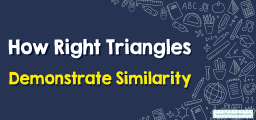Discovering the Magic of ASA and AAS Congruence in Triangles
Triangles, with their elegant three-sided structures, offer a plethora of intriguing properties. Among these are the postulates that determine their congruence. While we've previously discussed congruence through sides with the SSS and SAS postulates, let's now explore how angles play a central role with the ASA (Angle-Side-Angle) and AAS (Angle-Angle-Side) postulates. When we talk about congruent triangles, we mean that they have the same size and shape. But how can we determine congruence without comparing every single aspect? That's where the ASA and AAS postulates come to our aid. These postulates provide shortcuts, focusing on angles to ensure two triangles are congruent.

Step-by-step Guide: ASA and AAS Congruence
1. ASA (Angle-Side-Angle) Congruence Postulate:
If two angles and the included side of one triangle are congruent to two angles and the included side of another triangle, then the triangles are congruent. To use this postulate:
- Ensure you know the magnitudes of two angles and the length of the included side for both triangles.
- Compare these angles and the side.
- If both conditions are met, then the triangles are congruent.
2. AAS (Angle-Angle-Side) Congruence Postulate:
If two angles and a non-included side of one triangle are congruent to two angles and a non-included side of another triangle, then the triangles are congruent. To use this postulate:
- Make sure you know the magnitudes of two angles and the length of a side (that’s not between the two angles) for both triangles.
- Compare these angles and the side.
- If all match, then the triangles are congruent.
Examples
Example 1:
Are triangles with angles \(40^{\circ}\), \(90^{\circ}\) and a side of \(5 \text{ cm}\) (between the two angles) and another triangle with angles \(40^{\circ}\), \(90^{\circ}\) and a side of \(5 \text{ cm}\) congruent based on the ASA postulate?
Solution:
Both triangles have:
Angles of \(40^{\circ}\) and \(90^{\circ}\)
An included side of \(5 \text{ cm}\)
Since both the angles and the included side match, the triangles are congruent by the ASA postulate.
Example 2:
Are triangles with angles \(30^{\circ}\) and \(50^{\circ}\), and a non-included side of \(7 \text{ cm}\), and another triangle with angles \(30^{\circ}\) and \(50^{\circ}\), with a non-included side of \(7 \text{ cm}\) congruent based on the AAS postulate?
Solution:
Both triangles have:
Angles of \(30^{\circ}\) and \(50^{\circ}\)
A non-included side of \(7 \text{ cm}\)
Since the angles and the non-included side match, the triangles are congruent by the AAS postulate.
Practice Questions:
- Are triangles with angles \(60^{\circ}\) and \(80^{\circ}\), and a non-included side of \(10 \text{ cm}\), and another triangle with angles \(60^{\circ}\) and \(80^{\circ}\), with a non-included side of \(11 \text{ cm}\) congruent by the AAS postulate?
- Are triangles with angles \(70^{\circ}\) and \(110^{\circ}\), and an included side of \(12 \text{ cm}\), and another triangle with angles \(70^{\circ}\) and \(110^{\circ}\), with an included side of \(12 \text{ cm}\) congruent by the ASA postulate?

Answers:
- No
- Yes
Related to This Article
More math articles
- How to Interpret Remainders of Division Bigger Numbers Via One-digit Numbers
- 10 Most Common 4th Grade ACT Aspire Math Questions
- The Ultimate 6th Grade ISASP Math Course (+FREE Worksheets)
- How to Find Determinants of a Matrix?
- How to Solve the Converse of Pythagoras’ Theorem Problems?
- Mastering the Basics: The Significance of “Algebra I for Beginners” in Your Back-to-School List
- Mastering the Art of Integration: Vector-Valued Functions Explored
- Full-Length SSAT Lower Level Math Practice Test
- Poker & Probabilities: Is The Game About Luck or Skill?
- 7th Grade MAP Math Practice Test Questions


























What people say about "Discovering the Magic of ASA and AAS Congruence in Triangles - Effortless Math: We Help Students Learn to LOVE Mathematics"?
No one replied yet.